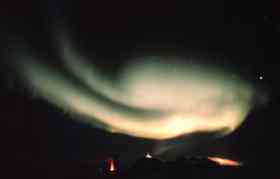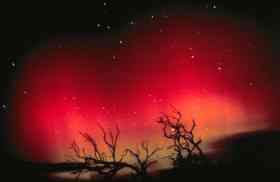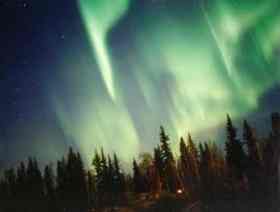 |
 |
| Home | Welcome | What's New | Site Map | Glossary | Weather Doctor Amazon Store | Book Store | Accolades | Email Us |
 | |||||||||||||||
Weather Almanac for February 2000LIGHT SHOW OF THE HEAVENSI hear forecasters predict that the Year 2000 will begin a period of intensive storminess which may cause global disruptions in communications and electric power distribution. And this forecast has nothing to do with global warming, El Niño/La Niña, or even the presence of the groundhog's shadow. To understand this forecast we have to step back from the Earth's surface, way back, even beyond the stratosphere for a good look. Oh yes, I forgot to tell you, please turn around to view the source of the storminess, for the storms that are coming will occur first on the face of the Sun. Sometime in 2000, we will enter the next peak period of the Sun's 11.2 year cycle of solar activity. (The previous solar maximum occurred in 1989.) During these peak activity years, the surface of the sun frequently erupts with solar flares, and sunspot numbers are at a maximum. Predictions for the current cycle indicate that it will be a strong and active cycle with peak sunspot number of 160. This level of sunspot numbers would place the current cycle third on the list of the 23 cycles that have been observed in detail since 1750. The region of space that extends from the surface of the Sun out to, and including, the Earth's ionosphere and magnetic field makes up the Sun-Earth environment. Although nearly a complete vacuum, it is an environment dominated by strong electromagnetic radiation and electrically charged particles emitted from the Sun. Changes in the conditions of the Sun-Earth environment are termed space weather. Severe space weather can cause significant damage to orbiting electronic systems, particularly those involved in global communications, and to surface electrical power grids. [For more on space weather, click here.] One of the main components of space weather is born on the surface of the sun. From the surface, energetic streamers of ionized gas, composed mainly of hydrogen, continuously sweep across interplanetary space toward Earth. They do so at supersonic speeds ranging from 300 to over 1000 km per second (675,000 to 2,250,000 mph). These streams are called the solar wind. When solar storms rage on Sol's surface, as they do during solar cycle maxima periods, they send out large and active bursts of particles toward Earth, changing the speed or density of the solar wind. When the solar wind strikes the Earth's magnetic field, it distorts and energized it, producing a condition known as a geomagnetic storm. Severe geomagnetic storms are natural hazards like hurricanes and tsunamis that may cause communications disruptions and alter the orbits of spacecraft and satellites. The storms may also cause surges in electric power lines and equipment failures in the power grid that can result in electric power blackouts over a wide area. Geomagnetic storms can last several hours or even days, and storm can surge several times a day as the solar wind "gusts" against the Earth. The Earth's magnetosphere, a magnetic force field around the planet, acts as a protective barrier for the planet's surface. The magnetosphere deflects most of the energetic solar particles and electromagnetic radiation in the solar wind around the Earth like a stone diverts the water in a fast flowing stream. However, some electrons in the solar wind become trapped in the Earth's magnetic field and accelerate toward the polar regions and downward into the upper atmosphere above the geomagnetic poles.
The brightest and most common auroral color, a brilliant green-yellow, is produced by those oxygen atoms at roughly 100 km (60 miles) altitude. High-altitude oxygen atoms (about 320 km (200 miles) above Earth) will produce rare, all-red auroras when struck by very high energy particles. Nitrogen molecules in an ionized state will produce blue light while neutral nitrogen molecules create purplish-red colours when excited.  Auroras come in many shapes and sizes as well as a variety of colours. There are six main shape categories for auroral displays: arc or curtain, band, corona, patch, ray and veil. They may appear to hang static over the sky, they may dance and flutter or explode upward, or they may change colours or pulse in intensity, as the ever-changing magnetic field is disturbed by the storm. The aurora has inspired many myths, legends and superstitions, particularly for the peoples inhabiting the polar latitudes of the Northern Hemisphere. Their infrequent appearance at lower latitudes was generally taken as a harbinger of disaster or great dangers such as an oncoming war, death, or famine. However, in some cultures, the aurora was seen as a sign of an impending royal birth. Some mythologists believe that auroras kindled dragon legends in China and Europe when the people say blazing red auroras and believed them the beast's fiery breath.  The Inuit of Labrador, Canada, believe the aurora to be torch lights carried by spirits illuminating a heavenly pathway for the souls of people who died a violent death, They believed the spirits who lit those torches were visible in the aurora and could be seen kicking around a walrus skull in a soccer-like game. Similar beliefs were held by the native Inuit of Greenland, the Eskimo of Alaska, the Sami of Scandinavia and Russia, and native Siberians. Today most of us unfortunately live too close to the overwhelming lights of human civilization to see auroral displays. We have grown used to thinking of the aurora as a winter night phenomenon, but this is only because of the longer and darker nights and clearer skies during the winter season. In fact, as orbiting satellites show, the auroral ring glows at each magnetic pole, waxing and waning with the solar wind. The satellites also show us that auroras are common daily events, They dance even in daylight, but the sun's overwhelming light obscures their faint glow in the sky. [For a current picture of the auroral oval, visit the US Space Environment Center (NOAA) site dedicated to auroral and upper atmospheric observations (www.sec.noaa.gov/pmap/). Although I have lived most of my life north of 45 degrees latitude, most of my sightings of aurora have come during the summer months in the Great Lakes region. I only have witnessed one dazzling display of the Northern Lights. The others have been pale veils or patches in which most of the colour has been removed by the humid and dusty atmosphere.  My one great experience with an auroral display took place on a small lake outside Hayward, Wisconsin during the latter years of the 1960s. (Perhaps 1966 or 1967, a previous solar cycle maximum.) My family had traveled to a small lodge during early August for a fishing holiday. We had emerged from our cottage just before midnight to do some night fishing. While sitting in the rowboat a hundred yards from shore, I happened to look skyward, something I do every chance I get, and noticed a blue-green cloud dancing in the sky above. Because of the bright moon light, it took a few moments before I realized I was watching an auroral curtain shimmering above us. For most of that night, my mind was more on the sky above than the fish below me. It was the only night of the week we spent at the lake, I recall, when such a striking auroral display was visible. With the return of another solar maximum this year, I look forward to again seeing a shimmering, dancing, multicolored auroral display. Because of the higher vulnerability of our satellites and power grids to geomagnetic storms, we will likely be hearing news reports of the more intense solar storms over the next year. So, if you hear the news anchor or some scientists reporting concerns over space weather, have a weather eye for the night skies, particularly in the northern and northeastern quadrants (for most North Americans). You may be treated to one of nature's most spectacular visages, courtesy of Ol' Sol and Mother Earth. Note: All photographs and diagrams courtesy of NOAA, US Department of Commerce. Learn More From These Relevant Books
|
|||||||||||||||
 |
To Purchase Notecard, |
Now Available! Order Today! | |
 |
 |
NEW! Now |
The BC Weather Book: |


